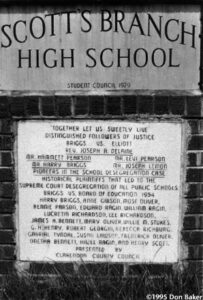Don Baker
- 1995

Fellowship Title:
- Legacy of Brown vs. Board of Education
Fellowship Year:
- 1995

Integration’s Victims: When Virginia Slammed the School Doors Shut
Six-year-old Shirley Ann Davidson had looked forward to starting school for a long time. Her mother had prepared her well, giving her the basics of arithmetic and reading from a Dick-and-Jane book to teach her the alphabet. During the summer before Shirley was scheduled to start first grade in Prince Edward County, Virginia, her mother made her a couple of new dresses and drove her into town for a vaccination and checkup. The year was 1959. A schoolgirl photograph of Shirley Ann Davidson at age 15, in 1967. But on the day school was to begin, Shirley’s mother cryptically announced that “it wasn’t time yet” for her little girl to begin classes. The terse news was made even more puzzling when Shirley, the only black and only girl of school age in her neighborhood, watched her sometime playmates, Tommy and Billy, who were white, gallop down the driveways of their houses to board a school bus. The right time for Shirley to begin school, it turned out, would not come for four years, as she

Education’s Cast-Offs: How Whites Avoid Integration and Leave Blacks Adrift
SUMMERTON, South Carolina – The orange-and-blue cover on the yearbook at Scott’s Branch High School here proclaims this sleepy Southern town as “the birth place of equal education,” but a look inside the town’s gleaming new $8 million school building belies that promise. Scott’s Branch, which was the locus of the first law suit that successfully challenged segregated schools in the nation, is barely more integrated today than it was four decades ago, when the U. S. Supreme Court declared “separate but equal” schools unconstitutional. The plaque at the old high school in Summerton, S.C. states, with no irony, “Together Let us Sweetly Live.” Yes, the separate and unequal dual school systems that existed before the 1954 Brown vs. Board of Education ruling are gone, but in their place is a unitary school district ceded to African-Americans by whites. Of the 1,365 students enrolled in Clarendon District One, the official name of the junior-senior high school and two elementary schools here, just 16 are white, and most of them are in the lower grades. There
